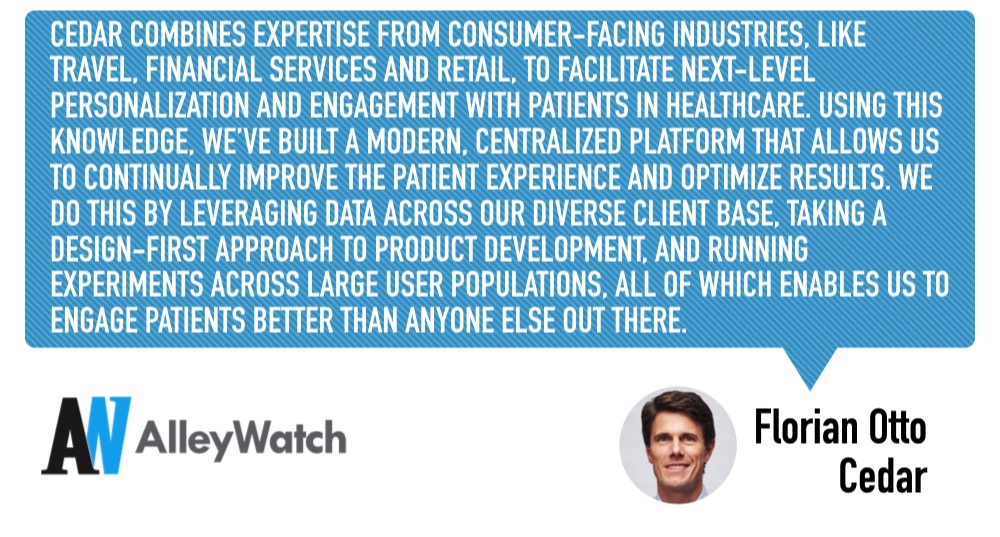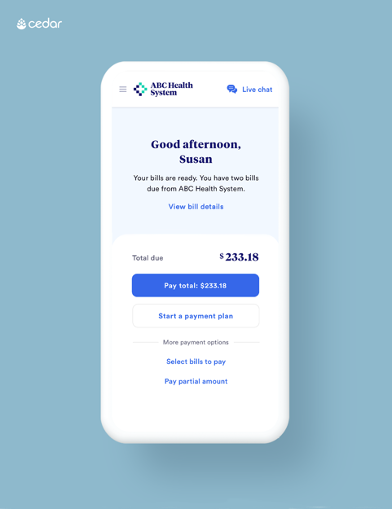You shouldn’t have to be a medical expert to comprehend a medical bill and is the patient-centric platform that improves the process of paying for healthcare services. Cedar Pay, the company’s initial flagship product, delivers a personalized experience that provides patients with a bill that is clear, and comreprenhsible, with convenient payment options. Cedar is now launching a full patient engagement platform that will ensure patients understand the financial costs pre-procedure, as well as helping them to pay post-procedure. Cedar is partnering with Novant Health to pilot this technology that includes appointment reminders, digital registration forms, and the ability to collect insurance information by taking a simple snapshot of the insurance card. Cedar’s innovative, forwarding looking solutions are fixing the problems with healthcare billing that has plagued the industry for too long. The platform is showing results – providers are experiencing a 30% increase in patient collection and consumers have driven a 70% increase in digital self-service payment adoption.
AlleyWatch caught up with CEO and Cofounder Florian Otto to learn more about how Cedar’s platform is building trust in the medical payment experience, engaging payments from the start of their medical journey, and the company’s latest funding round, which brings its total equity funding raised to $126M.
Who were your investors and how much did you raise?
Cedar just raised $102M in Series C funding, led by venture capital firm Andreessen Horowitz. The deal includes $77M in venture capital and $25M in venture debt.
Other participants in the fundraising round include Kaiser Permanente and individual angel investors including Jerod Mayo (linebacker coach for the New England Patriots) and Jeff Vacirca (MD, FACP and CEO of New York Cancer & Blood Specialists) as well as Cedar’s current investors including Kinnevik, Thrive Capital, Lakestar, and Founders Fund.
 Tell us about the product or service that Cedar offers.
Tell us about the product or service that Cedar offers.
Almost everyone I know has experienced a bad medical billing experience at some point. Medical bills are typically confusing and aren’t at all user-friendly or easy to resolve. We strongly believe that patients actually want to pay medical providers for the valuable care they receive, it’s just not easy to do so. This is the problem we are addressing. The Cedar platform enables an outstanding patient experience that empowers consumers to understand and resolve their medical bills. Our solutions help health systems, hospitals, and physician groups succeed in a world where patients are increasingly responsible for medical expenses.
Cedar’s initial product, Cedar Pay, provides medical bills that are intuitive and navigable, offers payment options that make sense for the individual, and engages patients to resolve balances in ways most convenient. Powered by data, Cedar Pay delivers a standout, personalized user experience that helps providers dramatically increase payments and reduce the cost to collect, while yielding higher patient satisfaction.
But to help solve the real problems of healthcare costs and price transparency, financial conversations need to happen earlier in the billing process, before patients even step foot in a medical facility.
That’s why we’re rolling out a comprehensive patient engagement platform that not only streamlines the post-visit financial experience but engages patients prior to receiving care. Our pre-service offering will help patients save time in the waiting room by enabling self-serve registration and prepayment as well as better anticipate out-of-pocket expenses well in advance of receiving the bill weeks after a visit.
What inspired the start of Cedar?
In 2016, I had a terrible billing experience when my wife (then-fiancé) fainted and had to go to the emergency room. She swiped her credit card for the co-payment at the facility but we still found ourselves dealing with a billing nightmare in the months that followed (including indecipherable stacks of paper bills, statements sent to the wrong address, and even a call from a debt collector). It became clear that if this was the financial experience for patients at a premier NYC hospital for people with the means to pay, it must be a pervasive problem in healthcare.
With my cofounder, Arel Lidow, we started Cedar to address this problem and improve the financial engagement experience for all patients. And today, that mission is as critical as ever. With many patients facing confusing new bills for COVID-19 treatment and the US reporting record levels of unemployment, patients need a better healthcare financial experience. Through that lens, Cedar’s mission couldn’t be more timely to enable exceptional patient experiences to improve lives, foster engagement, and transform US healthcare.
How is Cedar different?
Cedar is the only end-to-end healthcare consumer engagement platform. We enable healthcare providers to deliver a seamless, digital experience, taking patients through a contactless journey from pre-visit scheduling to post-visit billing with a convenient and modern interface that just doesn’t exist in healthcare today.
Also, our approach is unique. Cedar combines expertise from consumer-facing industries, like travel, financial services, and retail, to facilitate next-level personalization and engagement with patients in healthcare. Using this knowledge, we’ve built a modern, centralized platform that allows us to continually improve the patient experience and optimize results. We do this by leveraging data across our diverse client base, taking a design-first approach to product development, and running experiments across large user populations, all of which enables us to engage patients better than anyone else out there.
What market does Cedar target and how big is it?
Cedar’s addressable market is large and growing, driven by the increased prevalence of high-deductible insurance plans and growth in patient-cost sharing. Out-of-pocket healthcare expenditures reached $366B according to CMS National Expenditure data. An estimated 43% of all patient invoices go uncollected today (according to Cedar analysis of CMS National Expenditure data), as a result of which healthcare systems, hospitals and physician groups require more modern, consumer-friendly technology to engage patients more effectively on their growing financial obligations.
What’s your business model?
The Cedar business model is based on aligned incentives. In short: we get paid when our client partners see results. Our performance-based approach helps ensure that we continue to deliver the most innovative solutions to providers and an outstanding experience to patients. In addition, Cedar does not lock providers into multi-year agreements, and our historically low churn rate is a testament to the enduring relationships we develop and maintain with our clients.
How has COVID-19 impacted your business?
Like many businesses, we experienced a modest decline in short-term revenue related to elective procedures being postponed during the peak of the shut-down. However, we’re now seeing that volume rebound as patients start to return to their doctors for important delayed procedures and treatments.
Looking at the longer-term impact, we’ve seen a rapid acceleration in the pace of adoption of healthcare technology out of sheer necessity. Healthcare providers have moved more quickly and nimbly than ever before to implement the digital capabilities that patients need. The momentum that this drives and appetite for action from health systems are already beginning to have a meaningful positive impact on our business.
What was the funding process like?
Overall it was a very positive experience. We began reaching out to investors in early May with all the documents required. We then had several in-depth conversations and Q&A sessions with interested firms. Three weeks later we decided on the lead investor.
What are the biggest challenges that you faced while raising capital?
Conducting the entire process remotely over web meetings was not easy. It’s also challenging to gauge which investors are truly interested in the business and which just want to learn more.
What factors about your business led your investors to write the check?
The team at Andreessen Horowitz strongly believes in our mission. They understand that the current healthcare experience is broken and that Cedar offers a strong value proposition to the patient and provider. Scott Kupor also said he believes that the team has the capabilities to scale the company and build a long-lasting business that thrives.
What are the milestones you plan to achieve in the next six months?
Within the next six months, we aim to launch our pre-visit capabilities with several development partners across our key market segments. These partnerships will help us ensure that our full patient engagement platform meets the needs of different types of providers and complements their existing workflows and IT systems, including the most widely-used EHRs like Epic and Cerner. Concurrently, we will continue to build out our ecosystem of third-party partners and will be developing some existing new integrations to make the patient experience feel even more seamless.
Meanwhile, we will continue to scale up the team and prepare for the eventual reopening of our West Village office as it becomes safe for employees.
We will continue to build out our ecosystem of third-party partners and will be developing some existing new integrations to make the patient experience feel even more seamless.
Meanwhile, we will continue to scale up the team and prepare for the eventual reopening of our West Village office as it becomes safe for employees.
What advice can you offer companies in New York that do not have a fresh injection of capital in the bank?
Watch your expenses carefully and spend only in areas that are necessary to scale the business and get closer to your vision. It’s easy to hire too fast in parts of the organization that scale nicely without more people. So make a plan before hiring and then hold to it diligently.
Where do you see the company going now over the near term?
In the near-term, we’re focused on making the patient digital experience feel seamless for consumers. During a single episode of care, consumers are typically required to interact with numerous apps, paper forms, and portals to manage the different aspects of their healthcare; this results in an experience that feels fragmented and disjointed. Cedar will solve this problem by building a platform that supports a broad range of provider-to-consumer engagement use cases across the healthcare journey.
To achieve these objectives, we aim to ramp up our recruiting efforts in order to scale the team in areas like engineering, product, implementations, and partnerships. We will actively engage with ecosystem integration partners to help build out the services available to patients on our platform. And, we will invest in technology that personalizes the patient experience based on the unique needs of each consumer.
What’s your favorite outdoor dining restaurants in NYC
Hudson Clearwater in the West Village (because Zum Schneider closed).
You are seconds away from signing up for the hottest list in New York Tech! Join the millions and keep up with the stories shaping entrepreneurship. Sign up today




